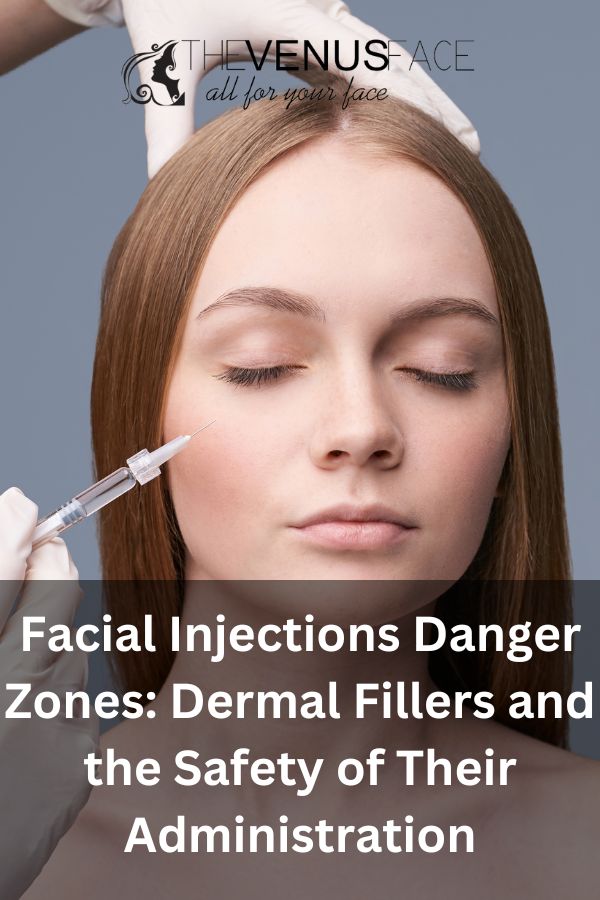Facial filler injections have become exceptionally popular over the last decade. With their help, thousands of people worldwide maintain their attractive and youthful appearance for as long as possible. However, it is worth mentioning that dermal fillers should be administered into a patient’s facial tissues exclusively by a certified healthcare provider.
So, how about taking a closer look at dermal fillers and the safety of their administration? Let us check out the general information on facial filler injections and their danger zones.
ON A SIDE NOTE: If you are currently looking for the most advantageous price of dermal fillers, check out OGOMED’s website. Here, you will find a wide range of brand-name medical and cosmetic injections with reasonable price tags.

What Are Dermal Fillers?
Above anything else, let us go through the most important details on soft tissue filler injections. Below, you will find information on their definition, types, indications, injection zones, contraindications, side effects, and expected results.
Definition
Dermal fillers might be defined as minimally invasive injectable products intended for professional use. Their main aim is to enhance and rejuvenate the overall appearance of a patient. The safety, quality, and effectiveness of dermal filler injections are strongly beloved by healthcare providers and their patients worldwide.
Types
Depending on the main active substance in their composition, there exist several dermal filler types, such as:
- Hyaluronic acid fillers;
- Calcium hydroxylapatite fillers;
- Poly-L-lactic acid fillers;
- And so on.
Each above-mentioned dermal filler type has its own peculiarities. However, all of them are characterized by high safety, strong effectiveness, and long-lasting duration of their results.
Indications & Injection Zones
In most cases, soft tissue filler injections are indicated for patients who have noticed the first signs of skin aging. More precisely, they are used to:
- Reduce fine lines, folds, and wrinkles (such as marionette lines, nasolabial folds, crow’s feet, and so on);
- Slightly enhance facial anatomy (by means of augmenting cheeks or chin);
- Augment lips and improve their contour;
- And so on.
Depending on the aesthetic issue a patient would like to address, a healthcare provider has to define what dermal filler type will do the best job in each individual case. For instance, if a patient wants to augment lips, a hyaluronic acid filler injection might be the most beneficial choice.
It is also worth mentioning that the vast majority of soft tissue filler injections are performed to enhance the facial zone of a patient. However, they might also be used to rejuvenate the neck, decollete, and even hands.
ON A SIDE NOTE: In some cases, injections of dermal fillers might have additional clinical implications. They should be thoroughly discussed with a healthcare provider.
Contraindications
Despite their high safety, injectable fillers should not be administered if a patient has any of the following contraindications to the treatment:
- Allergy to the main active substance of an injectable filler (for instance, hyaluronic acid in case of a hyaluronic acid filler injection or calcium hydroxylapatite in case of a calcium hydroxylapatite filler injection);
- Serious chronic disease (such as poor blood clotting);
- Ongoing inflammation of the skin around the intended injection site;
- And so on.
Moreover, a facial filler should not be injected deeply into a patient’s skin during pregnancy or breastfeeding.
Side Effects
In the case of the usage of high-quality products and proper injection techniques, facial filler injections do not cause any serious complications or adverse reactions. At the same time, however, they might lead to the appearance of several side effects, such as temporary skin irritation (including redness, itching, or swelling) or painful sensations around the injection site.
Under normal circumstances, these side effects do not require any medical supervision. They tend to fade away on their own within two to five days after the treatment. Still, a patient is recommended to contact a healthcare provider in case of any adverse reactions after the procedure (this way, a patient will be able to minimize risks and complications associated with them).
Expected Results
Soft tissue filler injections tend to provide a patient with instantly visible, natural-looking, and long-lasting results. In most cases, they last from several months to a couple of years (unless prolonged by periodical touch-up treatments). However, the exact duration of their results strongly depends on the individual peculiarities of each patient.
What Are the Danger Zones of Dermal Filler Injections?
The following facial danger zones require extreme caution and special attention during soft tissue filler injections:
- Brow and glabella zone. In order to perform an effective non-surgical rejuvenation of the brow and glabella danger zone by means of employing a filler, it is essential to be exceptionally careful and avoid injecting a filler into supraorbital and supratrochlear arteries that are located here;
- Temporal zone. When it comes to the temporal region of a patient’s face (especially the temporal fossa), it is essential to avoid an unintentional injection of a filler into a superficial temporal artery;
- Infraorbital zone. One of the reasons why the infraorbital zone (including the area around the medial canthus) requires special attention during soft tissue filler injections is because an accidental administration of a filler into the infraorbital artery might have serious consequences;
- Nasolabial zone. One more danger zone a healthcare provider should be cautious about when injecting facial fillers is the one around the nasolabial fold. It is important to avoid deep injections in this area to prevent any post-treatment complications (such as the breakage of an angular artery);
- Perioral zone. The two main things to take caution about when injecting a soft tissue filler in the perioral area, are the superior labial artery and inferior labial artery (since unintentional injections of a filler into these blood vessels might lead to severe complications, including lip tissue necrosis.
It is important to be careful when it comes to injections of fillers into facial vascular danger zones. Only by being exceptionally cautious, a healthcare provider will be able to reduce risks of vascular occlusion and intravascular necrosis.
ON A SIDE NOTE: Injections of facial fillers belong to procedures that should be performed exclusively by certified healthcare providers (like dermatologists, cosmetologists, plastic surgeons, and other licensed specialists).
Final Words
All in all, injections of dermal fillers belong to advantageous procedures that serve as minimally invasive alternatives to plastic surgery. To ensure their safety, it is essential to be especially careful when administering them around the perioral, nasolabial, infraorbital, temporal, brow, and glabellar danger zones.
So, how about finding a cautious healthcare provider and taking the maximum out of the administration of facial fillers? Enhance your beauty in a minimally invasive, risk-free, and safe way!


